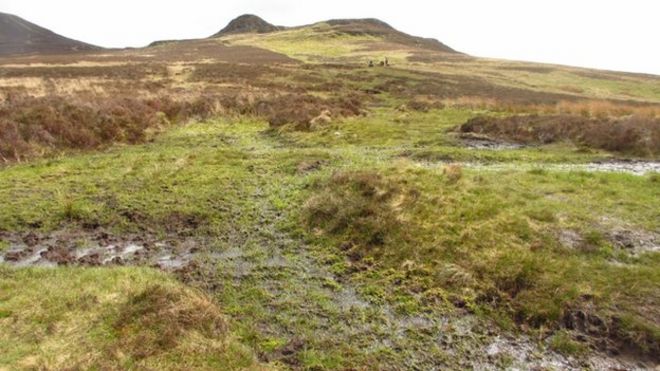Anyone who’s walked the Lake District will have had an
experience where they’ve sunk up to their knees in a bog. But next time you’re
cursing your soggy feet, bear in mind that bogs aren’t all bad – they’re
amazing habitats that also provide all sorts of important benefits for humans.
 |
| A typical boggy scene facing the hill-walker (LDNPA photo) |
There are a couple of types of bog in the Lakes. Blanket
bogs cover vast areas and sit on top of flat plateaus; these are mainly found
in the north and east Lakes, and are more typical of the Pennines and Peak
District. Much more common, especially around our patch in the south Lakes, are
flush bogs. These form in smaller, flat hollows on hillsides and hilltops where the
movement of rainwater slows down, leading to permanent waterlogging.
Sphagnum mosses
 |
| Sphagnum mosses are easily overlooked but they're beautiful species in their own right. Good quality bogs can hold around ten different species. (Photo Rob Clarke) |
The wet ground is colonised by carpets and hummocks of sphagnum mosses, which are ‘keystone
species’ in bog formation (species which produce an environment that other
species need to survive). Sphagnum thrive in the acidic flushes and create a
layer of peat, made from the dead plant material that doesn’t decompose due to
the cool climate, waterlogging and its own acidity. As the peat doesn’t decay
(as long as it remains waterlogged) it can build to many metres deep. This wet,
peaty environment then provides a home for other specialist plants such as
cottongrass, bog asphodel, cross-leaved heath, and the insectivorous sundews; they
subsequently support a specialist range of invertebrates, as well as birds like
curlews.
| Sundew growing amongst Sphagnum moss (Wikipedia photo) |
How bogs help us
Peat bogs aren’t just great for wildlife, they’re vital
for us too. By slowing down the flow of water off the hills, they reduce
flooding downstream, and help improve water quality. As the plant material that
is sat, undecomposed, in peat is primarily carbon, they are also a huge carbon
store – in the UK, they’re our biggest resource of carbon (with 22m tons stored
in the Lakes alone) and have a net cooling effect on the climate.
 |
| South Lakes rangers puzzle over the identification of a Sphagnum moss at one our important bogs (photo Rob Clarke). |
Bogs in trouble
Their importance for carbon storage and water management can
mean that threats to bogs have serious consequences. Over the last few decades,
peat has often been drained to improve grazing for sheep, and was traditionally
a source of fuel (although this practice is fortunately fairly rare in the UK
today). Dry, degraded peat bogs are prone to erosion from rain, which unlocks
stored carbon, increases the speed of run-off, and requires increased treatment
where water is collected for drinking. Eroding peat bogs in the Lakes are
thought to be emitting about 32,000 tons of carbon every year.
Here at South Lakes, we look after our flushes by damming
drainage ditches to ‘re-wet’ bogs that have previously been drained, and by
clearing the encroachment of trees where necessary, which can also dry them
out. We also build appropriate paths through bogs to ensure ease of access and stop people ploughing through sensitive habitat. Elsewhere in the country, huge projects are underway to re-wet entire
blanket bogs, often paid for by utility companies because it’s cheaper to improve
the water quality at source than to treat it when it comes out of the reservoir.
It’s likely that ‘eco-system services’ like this and carbon storage will
become an even more important part of our economy in future.
So, next time you’re confronted with a bog on your fell-top ramble,
try not to curse and remember all the wonderful things the unsung heroes of Sphagnum
and peat are doing for wildlife, and for us!
I am definitely enjoying your website. You definitely have some great insight and great stories. Singapore digital perm
ReplyDelete